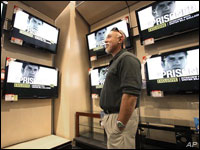
“Brought to you by …”
Ahhh, the golden age of advertising. The ads themselves were social markers, drivers of our conversation, definers of what was — and was not — cool. We took them at face value, we obeyed their siren songs, and we sampled, and we bought, and we sang the jingles.
Back in a few-network universe, when print mags had millions in circulation, when billboards could actually cut through the clutter and be memorable, the dawn of a new multimillion-dollar ad campaign was a PR event in itself. Ad Age celebrated it, The New York Times advertising column critiqued it. In short, advertising was a medium unto itself, and we considered it such.
How quaint those times seem now.
Think of advertising now as part of a larger continuum. It is no longer a medium. It is no longer entertainment. It is simply a link in a technical process of getting the right message in front of the right person at the right time.
It is a tactical event, waged as part of a larger war, crafted as much by techno-geek data brainiacs as much as swaggering admen from “Mad Men.” How did we get here? What happened?
Upsy Downsy
Think of the advertising and marketing world as a see-saw. On one side, the customer, the media is the fulcrum; the other side is the message. This see-saw started to tilt around 2001 and now is completely out of balance.
On the customer side, the marketing world has developed a series of services, platforms and tactics that have gathered an enormous amount of data about their target: preferences, past purchases, click-streams, demographics, geography, etc., are available in a way that would have made the old agency media buyer drool with desire.
The media fulcrum has also grown on data-steroids. We can buy “places” now — not just in print products or niche cable channels, but with dramatic specificity on the Web, down to the actual screen on the actual site for the actual type of person we need and want.
So, we know who they are, we know where they are, and yet, we show them a message that implies that we know nothing. It is a dumb message, identical for all who see it. This see-saw is tilted to on the side of the messenger, yet it fumbles the message. Why? Who is to blame? And what does it mean for the market planning of tomorrow?
Blame economics. To a great extent, the traditional advertising agency is still relying on funding its operations from a percentage of the media budget. That means that all the creative people and all the creative output are not compensated based on what they do, but rather on how much the client is prepared to give media companies to show their work.
So, as the number of media outlets has proliferated, as the number of free ways to generate buzz and awareness has exploded, the main structural value of the advertising agency has remained budget-constrained. It is an economic model that is under tremendous duress. It is starting to fray at the edges, and there will be consequences.
One vs. Infinity
First, agencies are just not able to economically “version” the message they and the client have agreed upon for all the various sub-genres of customers and prospects. They can’t afford to make the campaign flexible for the consumer. Seasonality, geography, demography, product feature appeal — all these are casualties of the agency cost structure that motivates them to be paid to make one ad and run it on one major network.
When I worked in the agency business, my bosses used to tell me the dream account was an airline. Make one beautiful TV ad (remember “Eastern — The Wings of Man”) and then spend millions on running that one image ad on all three major networks, collecting 15 percent of the cost of the simple three-insertion-order media buy. Clients like those would pay for the more expensive projects of a large pizza chain that was constantly changing themes, or flavors, or had lots of franchisees to cater to.
Now, agencies are asked to make an infinite number of messages, place them in an infinite number of places, and receive 15 percent of nothing. Does Facebook pay 15 percent on the media buy? This is an unsustainable financial model, and is partly the cause of the huge consolidation among advertising agencies that are trying to wring as much as they can out of their cost structure. However, it is a process with no good endgame.
Second: Watch out for consumer-blowback — in other words, revenge. The most desirable consumers KNOW that brand managers know a lot about what they do and where they are. These desirable targets have figured out that they sacrificed privacy long ago. The scanners that their purchases are run by are linked to their credit card and their frequent-purchaser program and their online catalog purchases. They know that they are being watched, categorized, rated, chased and targeted.
The price they pay for a lack of privacy is obvious as well. They see an ad for Hyundai when they browse the garden club schedule pages on their local newspaper Web site, and they know it’s because they just signed up for the extended warranty on their aging Buick. They KNOW that they are being tracked and watched. Yet that Hyundai banner ad talks about the roominess of its mini SUV and how you can pack camping gear in it — and they have never camped.
Ever.
Still Room for Magic
Soon, we are going to see consumers demanding custom attention based upon the sacrifice of their privacy on the altar of commerce. We will see the “punishment phase.” Savvy and demographically desirable consumers will begin to actively deny their patronage from companies that don’t take the time or make the effort to customize the appeal and focus the message. It won’t be “Eastern: The Wings of Man.” It will have to become, “JetBlue: The Wings for Stan.”
Lastly, you will begin to see convergence of those two trends. Brand managers will begin to let customers become their own ad agencies. They will let crowdsourcing platforms become the source of the message, the media, the buzz and the product features. In essence, the inmates will begin to run the asylum.
Whether it is contests like last year’s Doritos ad on the Super Bowl (won by two guys in Indiana who spent US$2,000 on the video) or other contests that ask product “zealots” to shape the message and version different appeals, the advertising will be created and placed by the customers. Research will be based on which buzz-drenched appeals get the most views on YouTube.
Another version of this will be that agencies and brand managers will begin to outsource creative work and versioning to a new class of professional creative collaborators. This “professional tier” of producers will be similar to Hollywood scriptwriters/script doctors — available on demand for project work to take a theme and expand on it, create new themes, or version out a specific appeal to hit customer sub-niches.
My predictions may sound dire, but, when you think about it, there is a rich history of this in other industries. When technology levels any playing field, the traditional “silo-like” providers of a service get leveled out themselves, and a new generation of providers emerges to satisfy industry and customer needs.
If you don’t believe me, ask the former members of the American Travel Agent Industry Association, the manager of classified advertising at the Newspaper Association of America, or the head of the Stockbrokers Industry Trade Association. Each saw consumers and new technologies reduce, or eradicate their market relevance.
It is a strange, and in some ways, wonderful new world. It’s a world of empowered consumers, demanding accountability from the messengers and brand managers who used to be able to reach everyone with the same appeal. It’s a world of tactics and platforms emerging to provide a customized outreach plan for each subset of prospects for the marketers to pitch. It’s a transparent world where click-throughs and “buy buttons” show everyone what is working, and when.
What will NEVER be answered is the WHY? Why did you buy Nike over Adidas? Burger King over McDonald’s? Holiday Inn over Motel 6? Developing an effective response to the age-old question of what really sells a product and what really engages a customer is still an art that cannot be distilled or quantified.
Great creative work still sells products. That much, we know, will never change. And we should all be happy that all the technology in the world cannot take away that magic and that beauty.
Mark Walsh is CEO and chairman of GeniusRocket, which connects experienced creative talent with companies seeking new marketing and advertising content.



































Social Media
See all Social Media